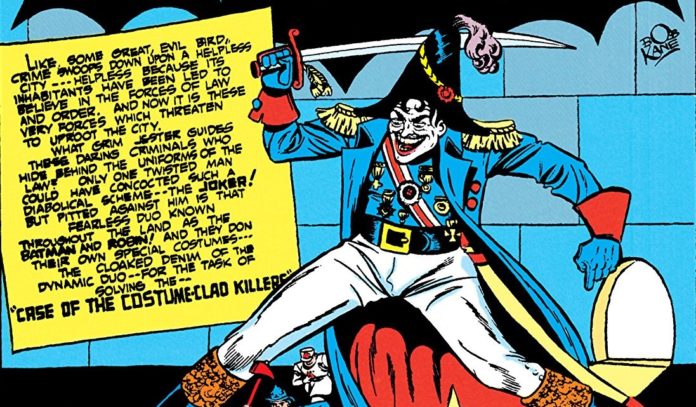PREVIOUS: A Joker’s Dozen, Part 8 (of 12)
One of the touchstones of The Joker’s interpretation in comics is the first dozen stories featuring the Joker that follow his introduction as a cold blooded killer and his transformation into a clever prankster that would bedevil Batman over the years without falling prey to the morality police. There are a dozen stories that make up this initial introduction, so 4 parts to go after this.
 The Comic/Story: “The Case of the Costume-Clad Killers” from DETECTIVE COMICS #60 (1942)
The Comic/Story: “The Case of the Costume-Clad Killers” from DETECTIVE COMICS #60 (1942)
The Return: No explanation, presumably The Joker escaped from Alcatraz in the interim.
The Plot: The Joker and gang commits a series of crimes costumed as soldiers, police men, firemen, etc.
Body Count: One via gunshot during a bank robbery
Joker’s Running Body Count: 22, plus potential car crash, train wreck, and bus crash victims
Other Mayhem: A soldier takes a sap to the head, a bank guard gets slugged with the butt end of a pistol, “firemen” shoot tommy guns at bystanders while making their getaway, two robberies at gunpoint, the Joker and his henchmen tangle with Batman and Robin on three occasions, Robin takes a gun butt to the head and is thrown over the side of a ship to drown, Batman is hit over the head, tied up, and dropped from a ship to drown.
The Outthink: Batman solves The Joker’s “cryptic” quip about his hideout location..
The Comeuppance: Batman and Robin take out the Joker and his gang in a fight. Next stop prison where The Joker vows his escape.

After the heights reached by “The Cross-Country Crimes” it was a return to the more mundane. The idea of using a variety of costumes to commit crimes isn’t a bad one, it will be revisited in 1943’s Rogues’ Pageant, but here there just isn’t any flair to the idea. Especially disappointing considering that mastery of disguise is one of The Joker’s trademarks. Not to mention the idea of extending The Joker’s mastery of disguise to his gang is rife with potential.One has to wonder if this story started as something of an inventory story, but had The Joker added in order to add some sizzle. In general, the early stories had slight nods to continuity with some explanation of The Joker’s various escapes. Here it starts with The Joker already escaped from Alcatraz with no explanation. Perhaps it was a story intended for another issue and either held up or sped up due to problems with other stories.
The story jumps right into the plot, after a nice splash page of the larger than life Joker clad as Napoleon while Batman and Robin fight off cops and firemen. A succession of robberies occur. Soldiers rob an armory of weapons. Fake police officers rob a bank, and shoot a guard for interfering. Firemen loot a burning building and fire machine guns at people during their getaway. Bruce Wayne and Dick Grayson remark on these crimes and speculate that it sounds like the handiwork of The Joker, when suddenly a new addition to Batman lore appears. The first appearance of the Batsignal which summons Batman and Robin to police headquarters. We’ve come a long ways to this point, February 1942, from the earliest stories where Batman was actively being hunted by the police. It’s also worth noting that while many ideas needed refining over time, the Batsignal has stayed virtually unchanged since the very beginning. If nothing else, this story is notable for introducing that idea.
At police headquarters there’s The Joker’s calling card, with a hand written message and clue for Batman and Robin to decipher. The relevant part of the clue is “and the weather won’t stop me from taking a fortune from under your noses!” Batman quickly puts the uniformed theme together with the post offices motto and deduces that the Joker is planning to rob the Post Office just a few blocks from police headquarters. Being proven right, a fight occurs involving all the props around the post office, sheets of stamps, mail bags, mail carts, etc. Soon, the Joker and his henchmen beat a hasty retreat in a mail truck with the Batmobile in pursuit. We quickly learn that the Batmobile is more advanced than the average car with puncture resistant tires that ignore the tacks and glass that The Joker throws in its way. However, as a second plan The Joker takes advantage of innocents by throwing money into the street which attracts children and forces the Batmobile to stop to avoiding killing kids.
That section is probably the highlight of the story. After The Joker’s escape, robberies are committed by “train conductors” and “elevator operators” and Batman responds with the familiar ploy of baiting a trap with a newspaper story about a fabulous diamond on a yacht, knowing of The Joker’s love of jewelry. And, of course, The Joker falls for it and soon a “Coast Guard” cutter with Captain Joker pulls up to a yacht only for Batman and Robin to swing into action. Unfortunately for the Dynamic Duo, Robin takes a blow to the head from The Joker and is thrown over the side to drown, although he manages to make it back aboard ship. Batman, distracted by Robin’s apparent demise, gets taken down too and after a brief debate about what to do with him, during which time a clue to their hideout is dropped, and the decision is made: Deathtrap! Batman is tied up and dangled over the ocean with a burning fuse to drop him in to drown, apparently like Robin. Batman gets dropped into the ocean alright, but some quick thinking and using the ship’s prop as a blade soon frees him.
And then it’s off to The Joker’s headquarters, a costume shop, where Batman and Robin, already in a costume inside the shop, converge on The Joker. And, of course, props come flying in from all directions. Curiously, the costume shop appears to be more like a sporting goods store with bows and even a boomerang lying around. The story ends with The Joker missing Batman and Robin with a boomerang and having it smack him in the face. Back to jail for him, with, of course, the promise to escape soon.
This is a hard issue to analyze since it doesn’t bring much new to the table, except perhaps emphasize The Joker’s love/hate relationship with authority figures. There have been better deathtraps and the apparent death of Robin was handled in much superior fashion in “The Case of the Honest Crook” in BATMAN #5 less than one year previous. The use of props in a fight is not very inspired either. It’s a competent story but one without any real spark and the seriousness of The Joker ironically seems to be holding back some of the fun the series is trending towards. – Robert Reineke
NEXT: “The Case of the Lucky Law-Breakers”
Robert Reineke watched BATMAN as a child in the 1970s and the scientist Batman may have had an influence on him pursuing a career in the sciences. Now he’s a Civil and Environmental Engineer residing in Wisconsin. He hosts the Still Watching the Skies podcast at Where the Long Tail Ends which reviews many of the overlooked science fiction films of the past. You can contact him at skiespodcast@gmail.com.











